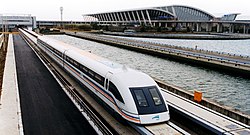Shanghai Street View: Troubled Technology

This week’s Street View takes us to Shanghai’s rapidly aging Maglev train, which was once the city’s pride and joy when it first opened in 2004 offering the world’s fastest speeds in a commercial rail service. The Maglev celebrated its 10th anniversary this year, even as debate grows about a technology that has been overtaken by slower but less costly high speed rail trains in the last few years.
More broadly speaking, the sputtering Maglev also shines a spotlight on Shanghai’s inability to become a leading center for technology development. As a China tech watcher for more than a decade, I can definitively say that my adopted city may be quite good at finance and other services, but is a relative laggard to Beijing and Shenzhen for high-tech development.
The Maglev system was in the headlines this past week as people debated the future of the 30.5-kilometer line that runs from the Longyang Road subway station to Pudong International Airport. That ground-breaking $1.2 billion line made global headlines when it began operations a decade ago, ferrying people back and forth at the record speed of up to 431 kilometers per hour. China once talked of building an entire national network based on the technology, with Shanghai standing at the epicenter of development by hosting the world’s first commercial line.
But the plans hit a roadblock after China failed to reach agreement with the German firms that developed the technology. In the absence of such a technology transfer agreement, Beijing decided to build a national network of trains that could travel at very high speeds, even if they weren’t quite as fast as the Maglev.
I assumed that maglev development was dead in China, but it seems the technology is still alive in several hot spots. One news report said several Chinese cities are developing their own maglev lines, including a Beijing line costing 17.6 billion yuan ($2.8 billion) that is now in the testing phase. The interior city of Changsha is also planning its own line, and similar plans have been discussed in Shenzhen.
As a longtime Shanghai resident, I remember frequently using the Maglev shortly after it first opened in 2004. In the early years people rode the train as much for its novelty as its convenience. Whoever designed the line didn’t do a very good job, because the Longyang station at its terminus was located in a difficult area to reach in Pudong.
That meant that anyone wanting to take the train to the airport first had to get to Longyang station. The Maglev trip itself took less than 10 minutes, but the combined time of getting to the station, buying a ticket and waiting for the next train meant that trips to the airport often could take an hour or more – the same as or longer than taking a taxi.
The opening of a subway line to Pudong Airport before the 2010 Shanghai Expo dealt the biggest blow by offering trips for far cheaper prices than the Maglev. In a bid to lower costs, the rail’s operator slowed down train speeds to a rate that was still quite fast but no longer reached the previous record, dampening enthusiasm from tourists. It also cut the trip frequency, meaning passengers sometimes had to wait up to half an hour for the next train.
I wasn’t surprised to read that Beijing and Shenzhen were among the cities planning to build their own maglev lines, as the pair have emerged as China’s high-tech leaders over the last decade. Beijing is home to many of China’s biggest Internet companies, including Baidu (Nasdaq: BIDU), Youku Tudou (NYSE: YOUK) and Sina (Nasdaq: SINA). Shenzhen is also a tech leader, hosting Tencent (HKEx: 700), China’s biggest Internet company, as well as telecoms giants Huawei and ZTE (HKEx: 763; Shenzhen: 000063).
By comparison, Shanghai is home to mostly second-tier tech players like game operator Shanda and chipmaker SMIC (HKEx: 981), which were once industry leaders but later failed to realize their potential. E-commerce giant Alibaba reportedly once considered making Shanghai its home, but later decided on Hangzhou due to Shanghai’s high costs.
Tech reporters often lament Shanghai’s lack of technology prowess, despite its efforts that include the building of a number of high-tech parks. It’s hard to say why the tech companies in Shanghai have failed to become national leaders, since the city has all the necessary infrastructure and talent to create a good environment for such development. I suspect one major reason is the government’s lack of longer-term commitment to cultivating such companies, which is clearly the case in the Maglev’s rapid fading into obscurity.
